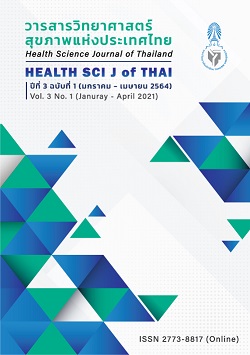Effects of a Nursing Program Development in Ischemic Stroke patients with Dysphagia on Aspiration Pneumonia Prevention at Stroke Unit, Phatthalung Hospital
Main Article Content
Abstract
This quasi-experimental research aimed to investigate the effects of nursing program development among ischemic stroke patients with dysphagia on aspiration pneumonia at Stroke Unit, Phatthalung hospital. The samples consisted of 88 stroke patients were recruited purposively. They were divided into two groups as experimental and control groups of 44 samples each group. The experimental group received the nursing program in ischemic stroke patients with dysphagia comprised of six phases: 1) swallowing assessment, 2) oral hygiene care, 3) swallowing muscles exercise, 4) nursing care for eating and feeding tube, 5) positioning for aspiration prevention, and 6) aspiration pneumonia assessment. The control group received a usual care. The data analysis was analyzed using descriptive statistics, Chi-square, and independent t-test. The results revealed that the incidence of aspiration pneumonia in the experimental group was significantly less than the control group (p <0.05). The length of stay and cost of treatment in the experimental group were significantly less than the control group (p <0.001). Therefore, nurses must apply this nursing program in stroke patients with dysphagia among all stroke patients in the hospital to prevent aspirate pneumonia.
Article Details
References
World Health Organization. World Stroke Campaign: [Internet] 2019 [cited 16 January, 2020]. Available from: http://www.world-stroke.org/assets/downloads/WSO_2019_Annual_Report_online.pdf.
Bureau of Policy and Strategy. Ministry of Public Health. Public Health Statistics: [internet] 2017 [cited 16 January, 2020]. Available from: http://www.bps.ops.moph.go.th/Healthinformation/statistic55/2.3.2_55.pdf.
Jauch, E.C., Saver, J.L., Adams, H.P., et al. Guidelines for the Early Management of Patients with Acute Ischemic Stroke: A Guideline for Health Professionals from the American Heart Association/ American Stroke Association. Stroke 2013; 44(3): 870-947.
Edmiaston, J., Connor, L.T., Loehr, L., Nassief, A. Validation of a Dysphagia Screening Tool in Acute Stroke Patients. American Journal of Critical Care: An Official Publication, American Association of Critical-Care. 2010; 19(4): 357-364.
Sharma, J.C., Fletcher, S., Vassallo, M., Ross, I. What influences outcome of stroke-pyrexia or dysphagia. International of clinical practice; 55(1): 17-20.
Longdon, P.C., Lee, A.H., Binns, C.W., Dysphagia in acute in ischemic stroke: Severity, recovery and relation to stroke subtype. Journal os Clinical Neuroscience, 2007; 14(7): 630-634.
Martino, R., Foley, N., Bhogel, S., Diamant, N., Speechley, M., Teasel, l.R. Dysphagia after stroke: incidence, diagnosis, and pulmonary complications. Stroke 2005; 36(12): 2756-63.
Krisna, P. Rehabilitation for Acute Ischemic stroke: Management of Acute Ischemic stroke. Bangkok: Chulalongkorn University; 2007. (In Thai)
Doggett, D.L., Tappe, K.A., Mitchell, M.D., Chapell, R., Caotes, V., Turkelson, C.M. Prevention of pneumonia in elderly stroke patients by systemic diagnosis and treatment of dysphagia: An evidence-based comprehensive analysis of the literature. Dysphagia 2001; 16: 275-295.
Cichero, J. Dysphagia foundation, theory and practice: Condition commonly associated with dysphagia, Chichester, UK: John Wiley&Sons; 2006; 237-298.
Prasat Neurological Institute. Clinical Nursing Practice Guideline for Stroke: [Internet] 2009 [cited 20 February, 2020]. Available from: http://thaineuronurse.com/cnpg/1.pdf.
Vose, A., Nonnenmacher, J., Singer, M.L., Gonzalez-Fernandez, M. Dysphagia management in acute and sub-acute stroke. Curr Phys Med Rehabil Rep. 2014; 2(4): 197-206.
Veis, S.L., Logemann, J.A. Swallowing disorders in persons with cerebrovascular accident. Arch Phys Med Rehabil. 1985; 66(6): 372-375.
Daniels, S.K., Brailey, K., Priestly, D.H., et al. Aspiration in patients with acute stroke. Archives of physical medicine and rehabilitation. 1998; 79(1): 14-9.
Piyapat, D. Dysphagia in Elderly. J Thai Rehabil Med. 2013; 23(3): 73-80. (In Thai)
Prasat Neurological Institute. Clinical Nursing Practice Guideline for Stroke. Enhancing Swallowing Safety in Stroke Patients with Dysphagia Guideline for Nurse. Bangkok: Prasat Neurological Institute; 2009.
Ya-in, S. Dysphagia Screening Test in Stroke Patients: Agreement of Evaluation Results Observed by a Registered Nurse. J Thai Rehabil Med. 2012; 22(1): 27-33. (In Thai)
Vividaki, L.E., Nasios, G., Kosmidou, M., Giannopoulos, S., Milionis, H. Swallowing and aspirate risk: A critical review of non-instrumental bedside screening test. J Clin neurol. 2018; 14(3): 265-274.
Thongniran, N., Sripaksa, K., Tuakta, P., Benjapornlert, P. The validity and reliability of modified Standardized Swallowing Assessment (SSA) to screen dysphagia in acute stroke patients. Journal of Thai Stroke Society 2020; 19(1): 16-27. (In Thai)
Boonkong, D., Promsakha Na Sakonnakorn, N., Utaisang, A., Boonkong, S. Enhancing Swallowing Safety in Stroke Patients with Dysphagia: A Challenging Role for Nurses. Journal of Boromarajonani College of Nursing 2019; 35(1): 13-23. (In Thai)
Sorensen, R.T., Rasmussen, R.S., Overgaard, K., Lerche, A., Johnansen, A.M., Lindhardt, T. Dysphagia screening and intensified oral hygiene reduce pneumonia after stroke. Journal of neuroscience nursing. 2013; 45(3):139-46.
Rofes, L., et.al. Pathophysiology of oropharyngeal dysphagia in the frail elderly. Neurogastroentrol Mobit. 2002; 22(8):851-858.
Neamcha, j., Suirt, P., Tiamkao, S. Effects of a Nursing Program for Hospitalized Patients with Acute Stroke on Aspiration and Pneumonia. Journal of Nursing and Health Care. 2017; 35(4): 167-175. (In Thai)
Minnerup, J., Wersching, H., Brokinkel, B., et al. The impact of lesion location and lesion size on post stroke infection frequency. J Neurol Neurosurg Psychiatry. 2010; 81(2): 198-202.
Lin, L.C., Wu, S.C., Chen, H.S., Wnag, T.G., Chen, M.Y., Prevalent of impaired swallowing in institutionalized older people in Taiwan. Journal of the American Geriatrics Society. 2002; 50(6): 1118-23.
Gordon C, Hewer RL, Wade DT. Dysphagia in acute stroke. British Medical Journal (Clin Res Ed). 1987; 295(6595): 411-414.
Thammakiat, A., & Hannarong, T. The Effects of Enchancing Swallowing Program on Swallowing Ability in Stroke Patients with Dysphagia at Neurological medicine ward, Suratthani hospital. Region 11 Medical Journal. 2018; 32(1): 813-820. (In Thai)
Moolkeaw, R. Effectiveness of Implementing Clinical Practice Guidelines for Dysphagia Management Among Stroke Patients. Thai Journal of Nursing and Midwifery Practice. 2016; 3(2): 44-57. (In Thai)
John, R.A., Benjamin, D.M. Aspiration pneumonia after stroke: Intervention and prevention. The Neurohospitalist. 2011; 1(2): 85-93.
Jantawises, U., Sathirapanya, P., Voragul, C., Wattanasit, Y., Yeesakul, C., Sasatranuruk, S. The result of the clinical pathway implementation for ischemic stroke patients in Songklanagarind hospital. Songkla Med J. 2009; 27(2): 117-129. (In Thai)


